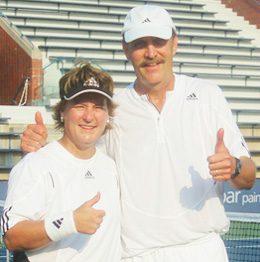| TennisOne Lessons Serve & Volley for More Doubles Wins Greg Moran For years I’ve told my students that high level doubles can best be described as a race to the net. I usually back up this statement by saying that 10-time Grand Slam doubles champion Anne Smith once told me that “the team that controls the net wins the point 85% of the time.”
Yes, Anne was star in the 80s and tennis has certainly changed since then, however, her point remains valid. Even in today’ game of supersonic groundstrokes and aggressive returns of serve, you give me two strong net players and I’ll place my money on them every time. With that in mind, each time you and your partner step to the line to serve, you have a built in head start in that all important race to the net. I’m talking about serving and volleying, and if your team can become adept at it, you’ll have huge advantage in every match you play. Before I get into the details, I must issue this disclaimer: to serve and volley successfully you must, I repeat, must have an effective serve. Day after day I watch recreational players push in a serve that can only be described as a slow moving balloon, charge the net like a bull in a china shop, and then not understand why they (and their partner) are getting drilled with the return. Do not attempt to serve and volley until you have developed an effective serve! It won’t work. What Defines an Effective Serve? An effective serve is one you can consistently hit in the box while, and at the same time, putting the receiver off-balance in some way. Contrary to popular opinion, achieving both usually doesn’t include power. Sure, blasting a big serve is one way to hurt your opponents and make you feel good, however, for several reasons, it’s rarely the best approach.
Every club in the world has those macho men and women tennis players, armed with their turbo-powered rackets and a grip it and rip it approach to serving. They toss the ball up in air, grit their teeth, and swing as hard as they can. They launch a rocket on their first serve, hoping that, if it goes in, they’ll get an easy point as well as intimidate their opponent with their “awesome” power. It’s a freebie in their minds because they know that if it misses they can always "plop" in their second serve and still be in the point. While this is not necessarily a bad strategy with the weekend wannabes who don’t have the skills to take advantage of a powder puff second serve, a strong player will eat those “plop" second serves for lunch. Big, flat serves have little room for error and the reality of it is that most players miss more big serves than they make. This leaves opponents foaming at the mouth as they wait for the weaker (virtually everyone’s is) second serve. Plus, the harder you hit your serve (if it does happen to go in), the faster it’s going to come back. This gives you less time to move in and prepare to volley. That's why you see a large number of doubles players hitting 3/4 pace first serves with lots of spin. A spin serve moves slower through the air than a flat ball, which gives the server more time to make the transition to the net. So, in regard to serving and volleying, push aside the power approach and, instead, focus on spin and placement. Be honest with yourself. Yes, the big boys and girls serve and volley, but if your serve is not up to par with the rest of your game, to do so will usually bring you more pain than pleasure. Commit to developing effective first and second serves that will allow you to serve and volley behind both. Read some of TennisOne’s great articles on serving and take to the practice court. Before you know it you’ll have a serve that’s a real weapon!
Keep Them Guessing Once you’ve developed that effective serve the next step is to think about where and how you’re going to deliver it. I’m constantly amazed when I see club players hit the same serve, to the same spot, over and over again and then not understand why their opponents are foaming at the mouth and drilling their returns back at their feet. Albert Einstein once defined insanity as “doing the same thing over and over again and expecting different results.” I think Einstein might have made a heck of a tennis coach. Move your serve around and vary the spin, height, and pace. I tell my players to hit 75 % of their doubles serve to two spots:
Both of these placements will put the receiver in an awkward position as well as make it difficult to return down the line, past your partner at the net. These serves will also reduce available angles and can set your partner up to poach. Adding spin to both of these placements will take these serves to the next level. Serves hit with topspin are particularly effective to come in behind as they’ll kick up out of the receiver’s strike zone and often force a weak return Also, use the slice and, yes, occasionally flat serves. Keep in mind that both of these serves will move faster through the air than a serve hit with topspin. This means that you won’t have as much time to prepare, so be sure to either make the receiver stretch or tie them up so they can’t get a good swing at the ball. Successful serve and volley players always focus on getting a high percentage of first serves in play. The Bryan brothers shoot for 70%. You should as well. The late Arthur Ashe had a great rule of thumb when serving. If he missed his first serve on two successive points, he would hit his second serve first, on the third point. Give it a try. Once you’ve decided where and how you’re going to serve (of course, your partner knows this as well), the ball’s now in your court. The success of the strategy will depend upon the quality of your serve, so take your time. Go through your serving ritual, visualize your target, toss the ball, and hit your spot. Serve and Sprint
As you strike the ball, explode towards the net and follow the path of your serve. You’ll have time for roughly 3 or 4 running steps. By then your serve will have crossed the net, bounced, and your opponent will be getting ready to hit the return. Just before he makes contact with the ball, take a strong split-step, see where the return is going, then make your move. The key moment of the serve and volley tactic is the first shot. Before hitting that shot, I would estimate your team’s chances of winning the point are roughly 50-50. However, if you can handle that first ball successfully, you should win the point 75% of the time. Try to play the first ball as a volley, though there will be times you’ll have to let it bounce and hit a half-volley. This is why the split-step is so crucial. Many players, in their urgency to get to the net will simply run right through (or into) their first shot. A successful split step gives you a slight pause as your opponent strikes the ball and allows you to re-balance, see what’s coming, and then decide how to play it. Many players struggle with the first shot because they try to do too much with it. Don’t make this mistake. As you’re transitioning from the baseline to the net you’re going to be running full speed, positioning yourself appropriately, while at the same time trying to anticipate what type of return your opponent is going to hit. Plus, when the time comes to play your shot, you’ll probably be 18 to 22 feet away from the net. Don’t make it more complicated by trying to hit an aggressive shot.
Yes, if your opponent pops up a short, high return, you may be able to move in and put the ball away by volleying down at the feet of the receiver’s partner, but don’t plan on it. Think of the first ball as an approach shot and focus on depth and placement. Aim deep and cross court with the goal being to push the receiver back behind his baseline. This requires a bit of feel so aim higher over the net and take some pace off the ball. Once you’ve successfully executed this first shot and have forced your opponent deep into his backcourt you can then settle in at the net with your partner, begin your net movement and anticipation strategies, while looking for the appropriate opportunity to end the point. Note: If the receiver’s partner is particularly active, he may try to poach as you hit your first shot. Once he does, hit the occasional first volley down the line to keep him honest. Otherwise, view your first volley as a transition shot and aim cross-court and deep. Coming in Behind Your Second Serve
If your second serve is weak (be honest with yourself), coming in behind it would be tennis suicide. Stay back and hope to get in on a subsequent shot. However, if you’ve truly developed a high level second serve, spin it in and get going to the net. Whether you use the serve and volley strategy on every point or now and then to keep your opponents guessing, commit to charging the net as soon as you step up to the line. Many players make the mistake of waiting to see what type of serve they’ve produced before charging forward. More often than not, this delay causes them to get caught having to play a defensive shot from an awkward area of the court. Once the decision to serve and volley is made, go after it 100%. Finally, serving and volleying is very physically demanding, so be sure to work on your off-court fitness. It doesn’t matter how great your net skills are, they’ll be useless if you can’t get in position, or are too tired, to execute them. Search TennisOne for drills that will increase your leg strength as well as improve your foot speed and movement. As with any new technique, learning to serve and volley successfully will take time. Be patient and remember that every missed volley or lost point is part of the learning process. Continue to practice and learn and before you know it, you and your partner will be serving and volleying your way to victory! Your comments are welcome. Let us know what you think about Greg Moran's article by emailing us here at TennisOne.
Tennis Doubles Beyond Big Shots
How to build your dream doubles team. Master the up-front and closeup game. Secrets to turning the tables on the serving team. Control the game without touching the ball. Add special shots to your doubles arsenal. How to play longer and enjoy more. Plus! Access to exclusive 50-minute video. To find out where to Purchase Greg Moran's new book, click here. |


